ABE 5UIBP0620: Performance Measurement Techniques for Bank of Maldives
VerifiedAdded on 2023/01/10
|19
|5746
|1
Report
AI Summary
This report provides an in-depth analysis of performance measurement techniques applicable to the Bank of Maldives, a prominent financial institution. The report begins with a brief overview of the bank, including its size, market operations, and key competitors. The core of the report focuses on proposing and evaluating various measurement techniques, including the Balanced Scorecard, Return on Capital Employed (ROCE), and Investor Ratios (Earnings per Share and Price/Earnings Ratio). Each technique is thoroughly examined, detailing its advantages and disadvantages in the context of the Bank of Maldives. The Balanced Scorecard's flexibility and strategic benefits are highlighted, while also acknowledging its complexity. ROCE's inclusion of both equity and debt is discussed, alongside its potential for accounting manipulation. Investor Ratios' ease of calculation and investment caliber are presented, with a focus on their ability to assess profitability and market valuation. The report aims to provide a comprehensive understanding of how these performance measurement techniques can be effectively utilized to assess and improve the Bank of Maldives' financial and overall business performance. The report adheres to the ABE open-book exam guidelines, ensuring that all sources are referenced and the content is relevant to the unit's syllabus.
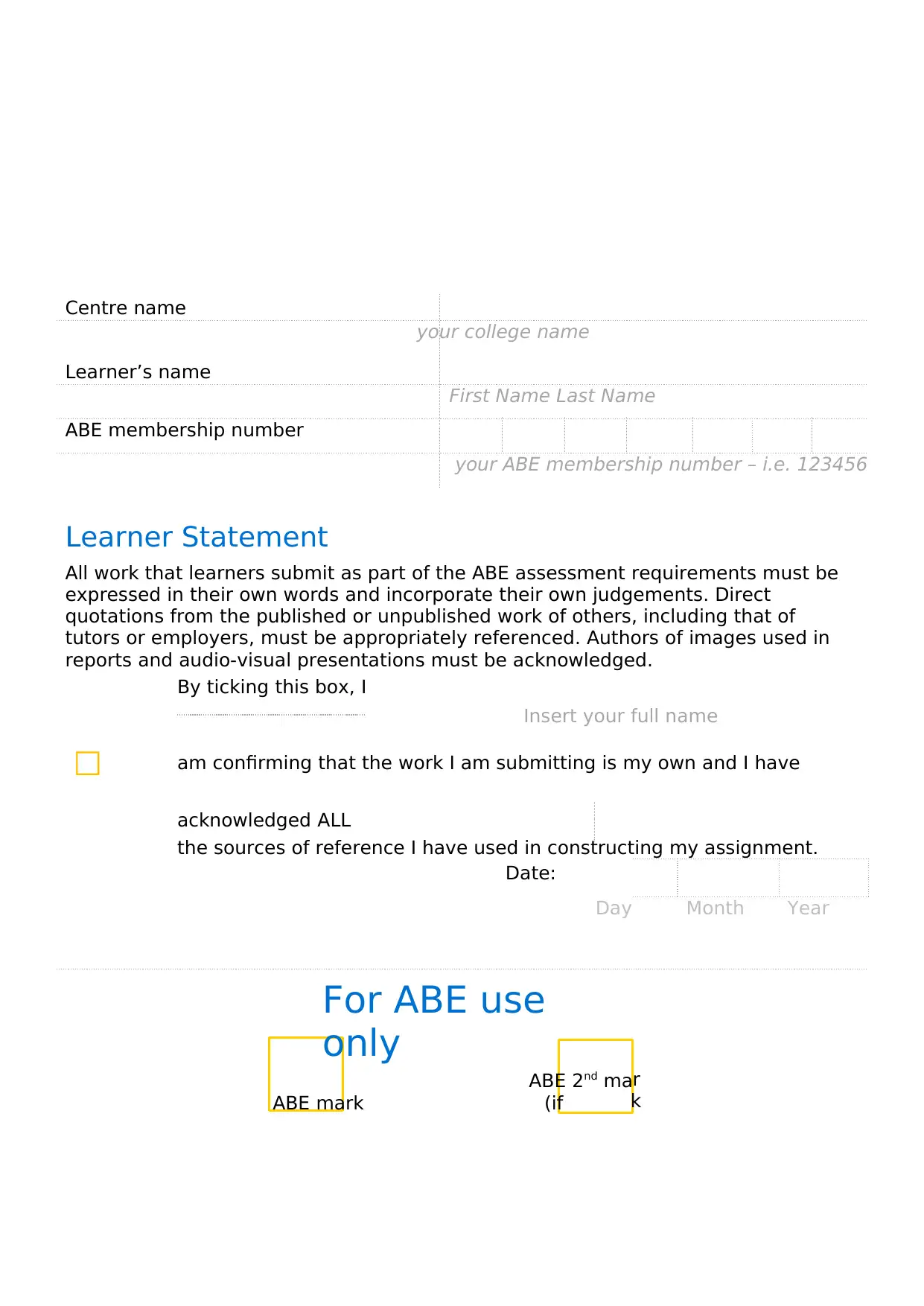
Centre name
your college name
Learner’s name
First Name Last Name
ABE membership number
your ABE membership number – i.e. 123456
Learner Statement
All work that learners submit as part of the ABE assessment requirements must be
expressed in their own words and incorporate their own judgements. Direct
quotations from the published or unpublished work of others, including that of
tutors or employers, must be appropriately referenced. Authors of images used in
reports and audio-visual presentations must be acknowledged.
By ticking this box, I
Insert your full name
☐ am confirming that the work I am submitting is my own and I have
acknowledged ALL
the sources of reference I have used in constructing my assignment.
Date:
Day Month Year
For ABE use
only ABE 2nd ma
ABE mark (if
r
k
your college name
Learner’s name
First Name Last Name
ABE membership number
your ABE membership number – i.e. 123456
Learner Statement
All work that learners submit as part of the ABE assessment requirements must be
expressed in their own words and incorporate their own judgements. Direct
quotations from the published or unpublished work of others, including that of
tutors or employers, must be appropriately referenced. Authors of images used in
reports and audio-visual presentations must be acknowledged.
By ticking this box, I
Insert your full name
☐ am confirming that the work I am submitting is my own and I have
acknowledged ALL
the sources of reference I have used in constructing my assignment.
Date:
Day Month Year
For ABE use
only ABE 2nd ma
ABE mark (if
r
k
Paraphrase This Document
Need a fresh take? Get an instant paraphrase of this document with our AI Paraphraser
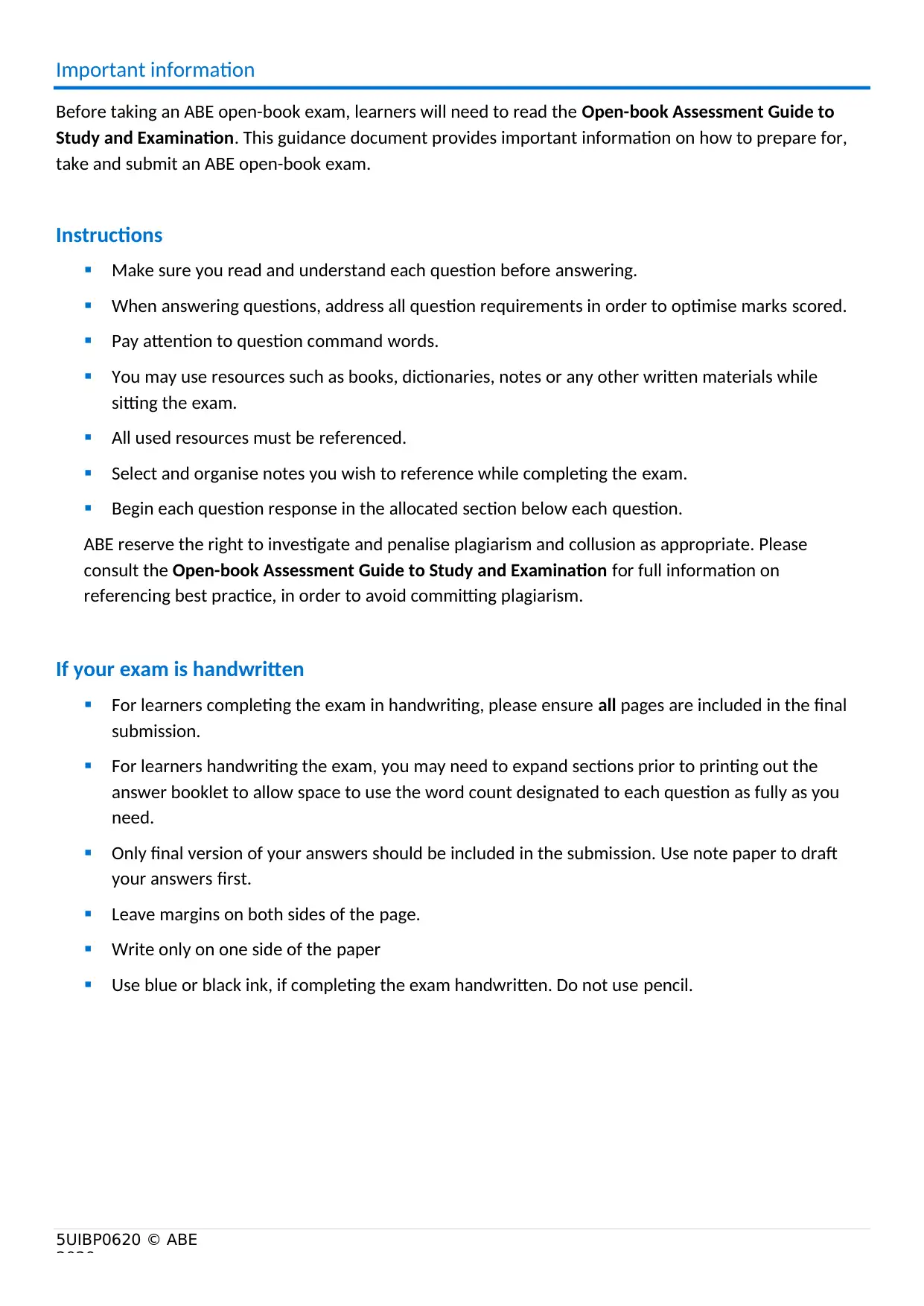
5UIBP0620 © ABE
2020
Important information
Before taking an ABE open-book exam, learners will need to read the Open-book Assessment Guide to
Study and Examination. This guidance document provides important information on how to prepare for,
take and submit an ABE open-book exam.
Instructions
Make sure you read and understand each question before answering.
When answering questions, address all question requirements in order to optimise marks scored.
Pay attention to question command words.
You may use resources such as books, dictionaries, notes or any other written materials while
sitting the exam.
All used resources must be referenced.
Select and organise notes you wish to reference while completing the exam.
Begin each question response in the allocated section below each question.
ABE reserve the right to investigate and penalise plagiarism and collusion as appropriate. Please
consult the Open-book Assessment Guide to Study and Examination for full information on
referencing best practice, in order to avoid committing plagiarism.
If your exam is handwritten
For learners completing the exam in handwriting, please ensure all pages are included in the final
submission.
For learners handwriting the exam, you may need to expand sections prior to printing out the
answer booklet to allow space to use the word count designated to each question as fully as you
need.
Only final version of your answers should be included in the submission. Use note paper to draft
your answers first.
Leave margins on both sides of the page.
Write only on one side of the paper
Use blue or black ink, if completing the exam handwritten. Do not use pencil.
2020
Important information
Before taking an ABE open-book exam, learners will need to read the Open-book Assessment Guide to
Study and Examination. This guidance document provides important information on how to prepare for,
take and submit an ABE open-book exam.
Instructions
Make sure you read and understand each question before answering.
When answering questions, address all question requirements in order to optimise marks scored.
Pay attention to question command words.
You may use resources such as books, dictionaries, notes or any other written materials while
sitting the exam.
All used resources must be referenced.
Select and organise notes you wish to reference while completing the exam.
Begin each question response in the allocated section below each question.
ABE reserve the right to investigate and penalise plagiarism and collusion as appropriate. Please
consult the Open-book Assessment Guide to Study and Examination for full information on
referencing best practice, in order to avoid committing plagiarism.
If your exam is handwritten
For learners completing the exam in handwriting, please ensure all pages are included in the final
submission.
For learners handwriting the exam, you may need to expand sections prior to printing out the
answer booklet to allow space to use the word count designated to each question as fully as you
need.
Only final version of your answers should be included in the submission. Use note paper to draft
your answers first.
Leave margins on both sides of the page.
Write only on one side of the paper
Use blue or black ink, if completing the exam handwritten. Do not use pencil.
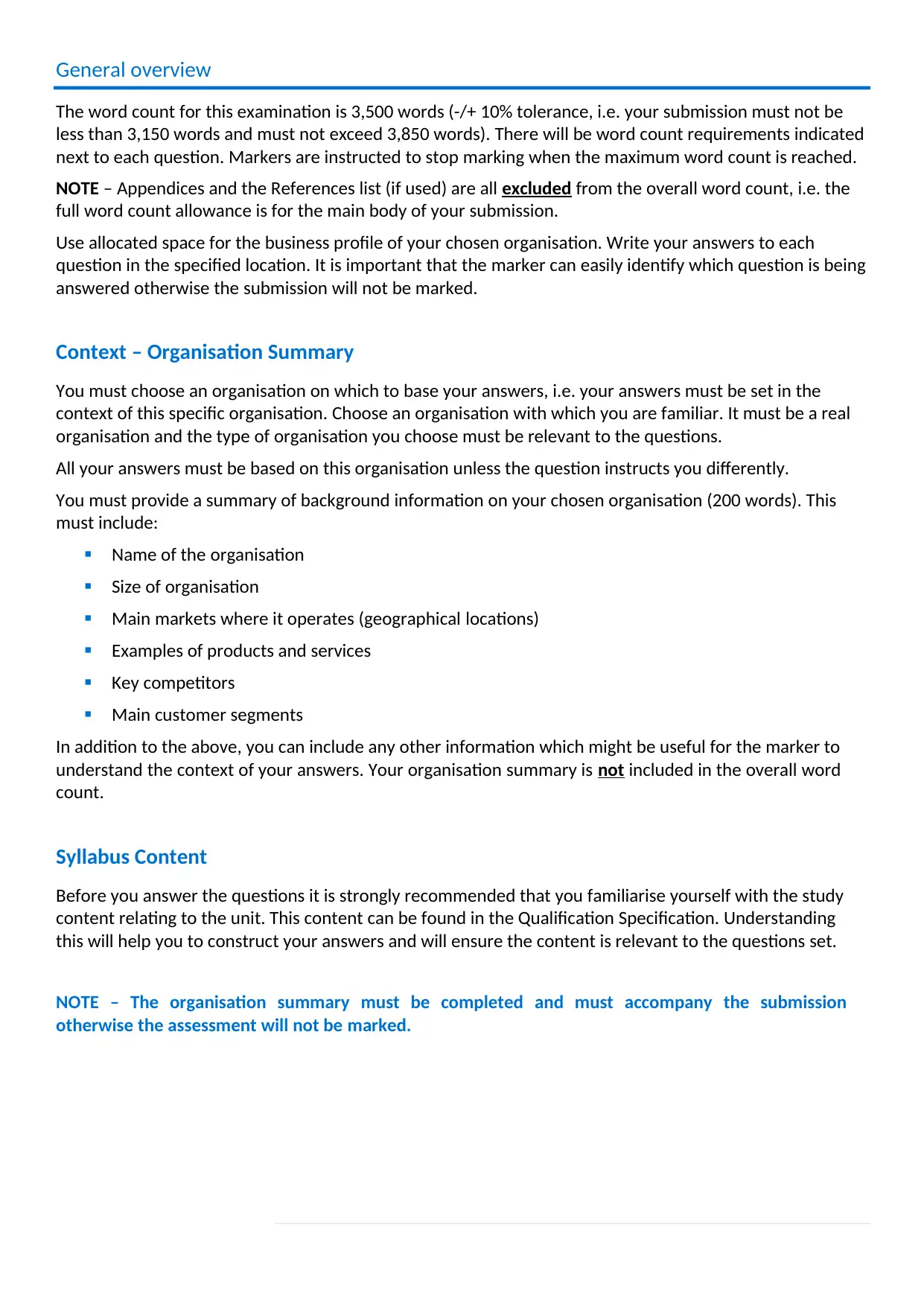
General overview
The word count for this examination is 3,500 words (-/+ 10% tolerance, i.e. your submission must not be
less than 3,150 words and must not exceed 3,850 words). There will be word count requirements indicated
next to each question. Markers are instructed to stop marking when the maximum word count is reached.
NOTE – Appendices and the References list (if used) are all excluded from the overall word count, i.e. the
full word count allowance is for the main body of your submission.
Use allocated space for the business profile of your chosen organisation. Write your answers to each
question in the specified location. It is important that the marker can easily identify which question is being
answered otherwise the submission will not be marked.
Context – Organisation Summary
You must choose an organisation on which to base your answers, i.e. your answers must be set in the
context of this specific organisation. Choose an organisation with which you are familiar. It must be a real
organisation and the type of organisation you choose must be relevant to the questions.
All your answers must be based on this organisation unless the question instructs you differently.
You must provide a summary of background information on your chosen organisation (200 words). This
must include:
Name of the organisation
Size of organisation
Main markets where it operates (geographical locations)
Examples of products and services
Key competitors
Main customer segments
In addition to the above, you can include any other information which might be useful for the marker to
understand the context of your answers. Your organisation summary is not included in the overall word
count.
Syllabus Content
Before you answer the questions it is strongly recommended that you familiarise yourself with the study
content relating to the unit. This content can be found in the Qualification Specification. Understanding
this will help you to construct your answers and will ensure the content is relevant to the questions set.
NOTE – The organisation summary must be completed and must accompany the submission
otherwise the assessment will not be marked.
The word count for this examination is 3,500 words (-/+ 10% tolerance, i.e. your submission must not be
less than 3,150 words and must not exceed 3,850 words). There will be word count requirements indicated
next to each question. Markers are instructed to stop marking when the maximum word count is reached.
NOTE – Appendices and the References list (if used) are all excluded from the overall word count, i.e. the
full word count allowance is for the main body of your submission.
Use allocated space for the business profile of your chosen organisation. Write your answers to each
question in the specified location. It is important that the marker can easily identify which question is being
answered otherwise the submission will not be marked.
Context – Organisation Summary
You must choose an organisation on which to base your answers, i.e. your answers must be set in the
context of this specific organisation. Choose an organisation with which you are familiar. It must be a real
organisation and the type of organisation you choose must be relevant to the questions.
All your answers must be based on this organisation unless the question instructs you differently.
You must provide a summary of background information on your chosen organisation (200 words). This
must include:
Name of the organisation
Size of organisation
Main markets where it operates (geographical locations)
Examples of products and services
Key competitors
Main customer segments
In addition to the above, you can include any other information which might be useful for the marker to
understand the context of your answers. Your organisation summary is not included in the overall word
count.
Syllabus Content
Before you answer the questions it is strongly recommended that you familiarise yourself with the study
content relating to the unit. This content can be found in the Qualification Specification. Understanding
this will help you to construct your answers and will ensure the content is relevant to the questions set.
NOTE – The organisation summary must be completed and must accompany the submission
otherwise the assessment will not be marked.
⊘ This is a preview!⊘
Do you want full access?
Subscribe today to unlock all pages.

Trusted by 1+ million students worldwide
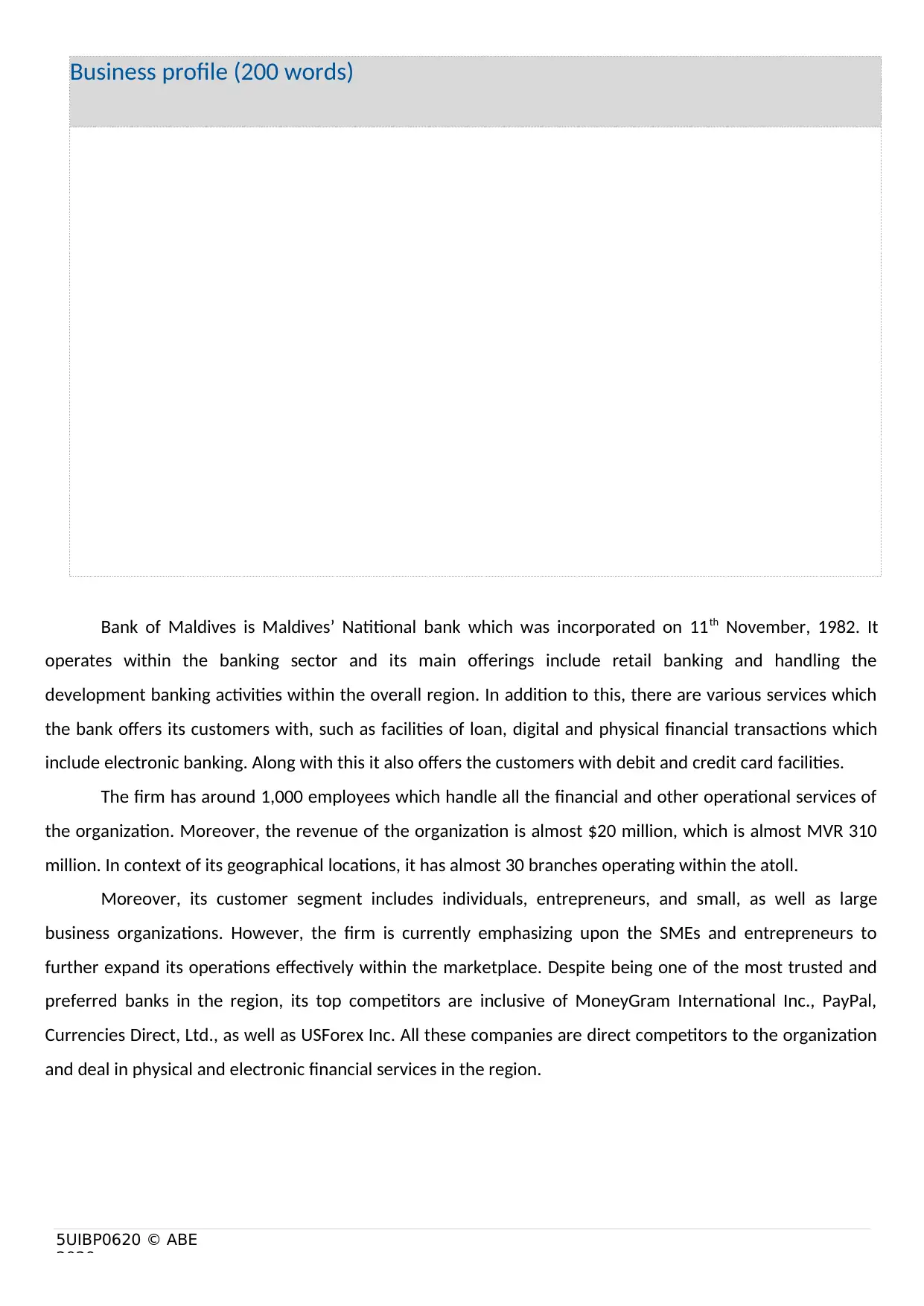
5UIBP0620 © ABE
2020
Business profile (200 words)
Bank of Maldives is Maldives’ Natitional bank which was incorporated on 11th November, 1982. It
operates within the banking sector and its main offerings include retail banking and handling the
development banking activities within the overall region. In addition to this, there are various services which
the bank offers its customers with, such as facilities of loan, digital and physical financial transactions which
include electronic banking. Along with this it also offers the customers with debit and credit card facilities.
The firm has around 1,000 employees which handle all the financial and other operational services of
the organization. Moreover, the revenue of the organization is almost $20 million, which is almost MVR 310
million. In context of its geographical locations, it has almost 30 branches operating within the atoll.
Moreover, its customer segment includes individuals, entrepreneurs, and small, as well as large
business organizations. However, the firm is currently emphasizing upon the SMEs and entrepreneurs to
further expand its operations effectively within the marketplace. Despite being one of the most trusted and
preferred banks in the region, its top competitors are inclusive of MoneyGram International Inc., PayPal,
Currencies Direct, Ltd., as well as USForex Inc. All these companies are direct competitors to the organization
and deal in physical and electronic financial services in the region.
2020
Business profile (200 words)
Bank of Maldives is Maldives’ Natitional bank which was incorporated on 11th November, 1982. It
operates within the banking sector and its main offerings include retail banking and handling the
development banking activities within the overall region. In addition to this, there are various services which
the bank offers its customers with, such as facilities of loan, digital and physical financial transactions which
include electronic banking. Along with this it also offers the customers with debit and credit card facilities.
The firm has around 1,000 employees which handle all the financial and other operational services of
the organization. Moreover, the revenue of the organization is almost $20 million, which is almost MVR 310
million. In context of its geographical locations, it has almost 30 branches operating within the atoll.
Moreover, its customer segment includes individuals, entrepreneurs, and small, as well as large
business organizations. However, the firm is currently emphasizing upon the SMEs and entrepreneurs to
further expand its operations effectively within the marketplace. Despite being one of the most trusted and
preferred banks in the region, its top competitors are inclusive of MoneyGram International Inc., PayPal,
Currencies Direct, Ltd., as well as USForex Inc. All these companies are direct competitors to the organization
and deal in physical and electronic financial services in the region.
Paraphrase This Document
Need a fresh take? Get an instant paraphrase of this document with our AI Paraphraser

5UIBP0620 © ABE
2020
OPEN BOOK EXAM QUESTIONS START ON THE NEXT PAGE
2020
OPEN BOOK EXAM QUESTIONS START ON THE NEXT PAGE
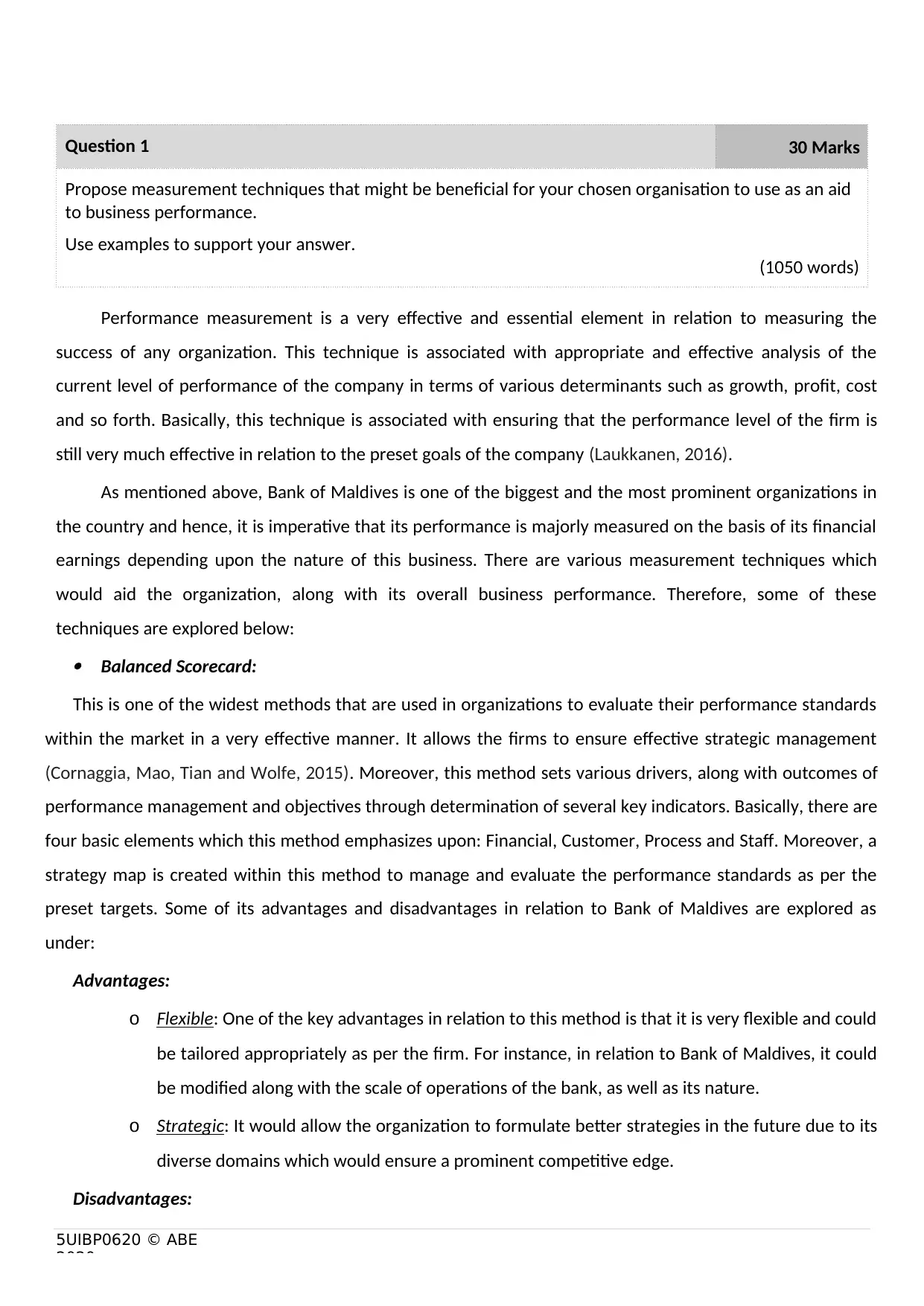
5UIBP0620 © ABE
2020
Question 1 30 Marks
Propose measurement techniques that might be beneficial for your chosen organisation to use as an aid
to business performance.
Use examples to support your answer.
(1050 words)
Performance measurement is a very effective and essential element in relation to measuring the
success of any organization. This technique is associated with appropriate and effective analysis of the
current level of performance of the company in terms of various determinants such as growth, profit, cost
and so forth. Basically, this technique is associated with ensuring that the performance level of the firm is
still very much effective in relation to the preset goals of the company (Laukkanen, 2016).
As mentioned above, Bank of Maldives is one of the biggest and the most prominent organizations in
the country and hence, it is imperative that its performance is majorly measured on the basis of its financial
earnings depending upon the nature of this business. There are various measurement techniques which
would aid the organization, along with its overall business performance. Therefore, some of these
techniques are explored below:
Balanced Scorecard:
This is one of the widest methods that are used in organizations to evaluate their performance standards
within the market in a very effective manner. It allows the firms to ensure effective strategic management
(Cornaggia, Mao, Tian and Wolfe, 2015). Moreover, this method sets various drivers, along with outcomes of
performance management and objectives through determination of several key indicators. Basically, there are
four basic elements which this method emphasizes upon: Financial, Customer, Process and Staff. Moreover, a
strategy map is created within this method to manage and evaluate the performance standards as per the
preset targets. Some of its advantages and disadvantages in relation to Bank of Maldives are explored as
under:
Advantages:
o Flexible: One of the key advantages in relation to this method is that it is very flexible and could
be tailored appropriately as per the firm. For instance, in relation to Bank of Maldives, it could
be modified along with the scale of operations of the bank, as well as its nature.
o Strategic: It would allow the organization to formulate better strategies in the future due to its
diverse domains which would ensure a prominent competitive edge.
Disadvantages:
2020
Question 1 30 Marks
Propose measurement techniques that might be beneficial for your chosen organisation to use as an aid
to business performance.
Use examples to support your answer.
(1050 words)
Performance measurement is a very effective and essential element in relation to measuring the
success of any organization. This technique is associated with appropriate and effective analysis of the
current level of performance of the company in terms of various determinants such as growth, profit, cost
and so forth. Basically, this technique is associated with ensuring that the performance level of the firm is
still very much effective in relation to the preset goals of the company (Laukkanen, 2016).
As mentioned above, Bank of Maldives is one of the biggest and the most prominent organizations in
the country and hence, it is imperative that its performance is majorly measured on the basis of its financial
earnings depending upon the nature of this business. There are various measurement techniques which
would aid the organization, along with its overall business performance. Therefore, some of these
techniques are explored below:
Balanced Scorecard:
This is one of the widest methods that are used in organizations to evaluate their performance standards
within the market in a very effective manner. It allows the firms to ensure effective strategic management
(Cornaggia, Mao, Tian and Wolfe, 2015). Moreover, this method sets various drivers, along with outcomes of
performance management and objectives through determination of several key indicators. Basically, there are
four basic elements which this method emphasizes upon: Financial, Customer, Process and Staff. Moreover, a
strategy map is created within this method to manage and evaluate the performance standards as per the
preset targets. Some of its advantages and disadvantages in relation to Bank of Maldives are explored as
under:
Advantages:
o Flexible: One of the key advantages in relation to this method is that it is very flexible and could
be tailored appropriately as per the firm. For instance, in relation to Bank of Maldives, it could
be modified along with the scale of operations of the bank, as well as its nature.
o Strategic: It would allow the organization to formulate better strategies in the future due to its
diverse domains which would ensure a prominent competitive edge.
Disadvantages:
⊘ This is a preview!⊘
Do you want full access?
Subscribe today to unlock all pages.

Trusted by 1+ million students worldwide
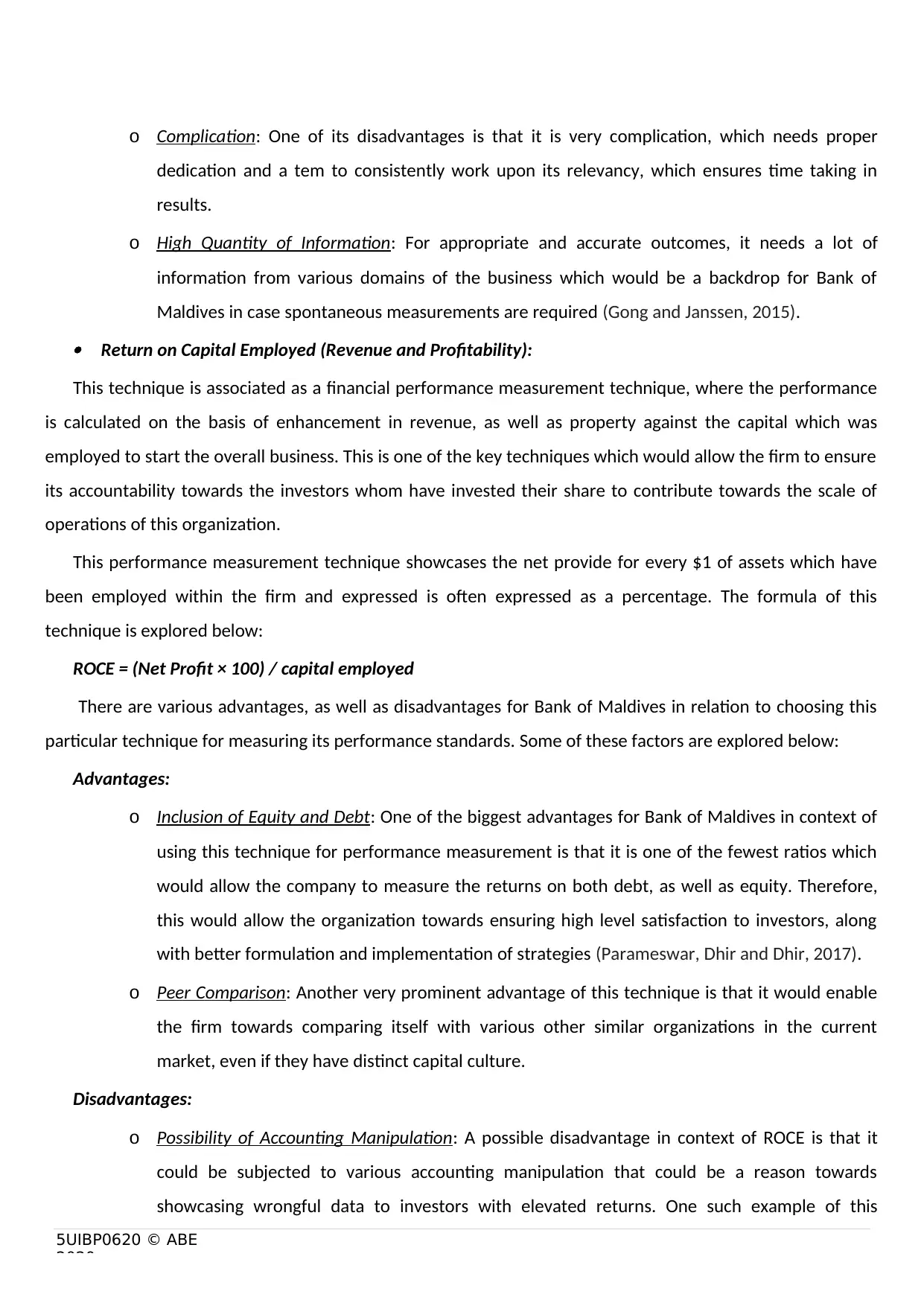
5UIBP0620 © ABE
2020
o Complication: One of its disadvantages is that it is very complication, which needs proper
dedication and a tem to consistently work upon its relevancy, which ensures time taking in
results.
o High Quantity of Information: For appropriate and accurate outcomes, it needs a lot of
information from various domains of the business which would be a backdrop for Bank of
Maldives in case spontaneous measurements are required (Gong and Janssen, 2015).
Return on Capital Employed (Revenue and Profitability):
This technique is associated as a financial performance measurement technique, where the performance
is calculated on the basis of enhancement in revenue, as well as property against the capital which was
employed to start the overall business. This is one of the key techniques which would allow the firm to ensure
its accountability towards the investors whom have invested their share to contribute towards the scale of
operations of this organization.
This performance measurement technique showcases the net provide for every $1 of assets which have
been employed within the firm and expressed is often expressed as a percentage. The formula of this
technique is explored below:
ROCE = (Net Profit × 100) / capital employed
There are various advantages, as well as disadvantages for Bank of Maldives in relation to choosing this
particular technique for measuring its performance standards. Some of these factors are explored below:
Advantages:
o Inclusion of Equity and Debt: One of the biggest advantages for Bank of Maldives in context of
using this technique for performance measurement is that it is one of the fewest ratios which
would allow the company to measure the returns on both debt, as well as equity. Therefore,
this would allow the organization towards ensuring high level satisfaction to investors, along
with better formulation and implementation of strategies (Parameswar, Dhir and Dhir, 2017).
o Peer Comparison: Another very prominent advantage of this technique is that it would enable
the firm towards comparing itself with various other similar organizations in the current
market, even if they have distinct capital culture.
Disadvantages:
o Possibility of Accounting Manipulation: A possible disadvantage in context of ROCE is that it
could be subjected to various accounting manipulation that could be a reason towards
showcasing wrongful data to investors with elevated returns. One such example of this
2020
o Complication: One of its disadvantages is that it is very complication, which needs proper
dedication and a tem to consistently work upon its relevancy, which ensures time taking in
results.
o High Quantity of Information: For appropriate and accurate outcomes, it needs a lot of
information from various domains of the business which would be a backdrop for Bank of
Maldives in case spontaneous measurements are required (Gong and Janssen, 2015).
Return on Capital Employed (Revenue and Profitability):
This technique is associated as a financial performance measurement technique, where the performance
is calculated on the basis of enhancement in revenue, as well as property against the capital which was
employed to start the overall business. This is one of the key techniques which would allow the firm to ensure
its accountability towards the investors whom have invested their share to contribute towards the scale of
operations of this organization.
This performance measurement technique showcases the net provide for every $1 of assets which have
been employed within the firm and expressed is often expressed as a percentage. The formula of this
technique is explored below:
ROCE = (Net Profit × 100) / capital employed
There are various advantages, as well as disadvantages for Bank of Maldives in relation to choosing this
particular technique for measuring its performance standards. Some of these factors are explored below:
Advantages:
o Inclusion of Equity and Debt: One of the biggest advantages for Bank of Maldives in context of
using this technique for performance measurement is that it is one of the fewest ratios which
would allow the company to measure the returns on both debt, as well as equity. Therefore,
this would allow the organization towards ensuring high level satisfaction to investors, along
with better formulation and implementation of strategies (Parameswar, Dhir and Dhir, 2017).
o Peer Comparison: Another very prominent advantage of this technique is that it would enable
the firm towards comparing itself with various other similar organizations in the current
market, even if they have distinct capital culture.
Disadvantages:
o Possibility of Accounting Manipulation: A possible disadvantage in context of ROCE is that it
could be subjected to various accounting manipulation that could be a reason towards
showcasing wrongful data to investors with elevated returns. One such example of this
Paraphrase This Document
Need a fresh take? Get an instant paraphrase of this document with our AI Paraphraser
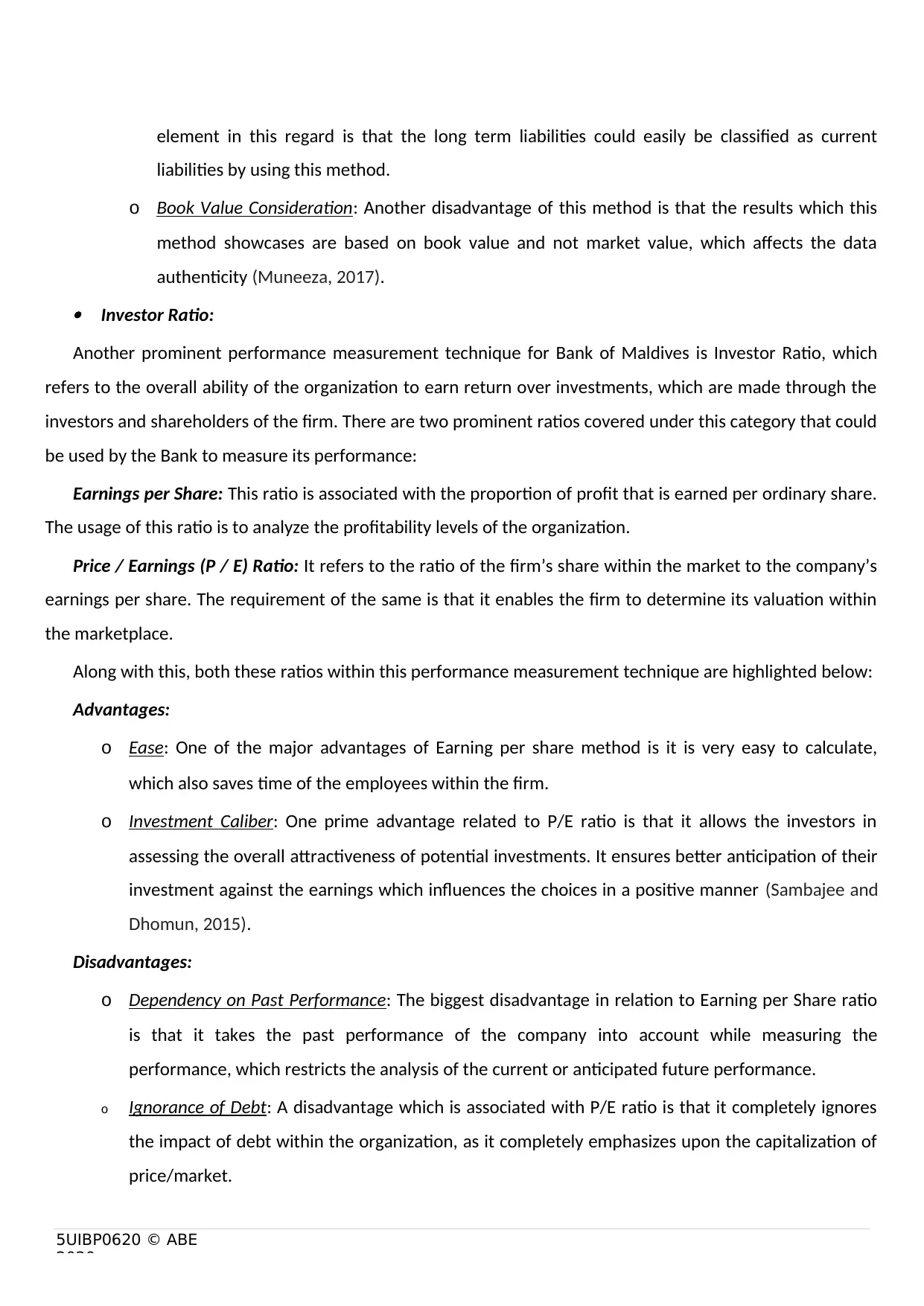
5UIBP0620 © ABE
2020
element in this regard is that the long term liabilities could easily be classified as current
liabilities by using this method.
o Book Value Consideration: Another disadvantage of this method is that the results which this
method showcases are based on book value and not market value, which affects the data
authenticity (Muneeza, 2017).
Investor Ratio:
Another prominent performance measurement technique for Bank of Maldives is Investor Ratio, which
refers to the overall ability of the organization to earn return over investments, which are made through the
investors and shareholders of the firm. There are two prominent ratios covered under this category that could
be used by the Bank to measure its performance:
Earnings per Share: This ratio is associated with the proportion of profit that is earned per ordinary share.
The usage of this ratio is to analyze the profitability levels of the organization.
Price / Earnings (P / E) Ratio: It refers to the ratio of the firm’s share within the market to the company’s
earnings per share. The requirement of the same is that it enables the firm to determine its valuation within
the marketplace.
Along with this, both these ratios within this performance measurement technique are highlighted below:
Advantages:
o Ease: One of the major advantages of Earning per share method is it is very easy to calculate,
which also saves time of the employees within the firm.
o Investment Caliber: One prime advantage related to P/E ratio is that it allows the investors in
assessing the overall attractiveness of potential investments. It ensures better anticipation of their
investment against the earnings which influences the choices in a positive manner (Sambajee and
Dhomun, 2015).
Disadvantages:
o Dependency on Past Performance: The biggest disadvantage in relation to Earning per Share ratio
is that it takes the past performance of the company into account while measuring the
performance, which restricts the analysis of the current or anticipated future performance.
o Ignorance of Debt: A disadvantage which is associated with P/E ratio is that it completely ignores
the impact of debt within the organization, as it completely emphasizes upon the capitalization of
price/market.
2020
element in this regard is that the long term liabilities could easily be classified as current
liabilities by using this method.
o Book Value Consideration: Another disadvantage of this method is that the results which this
method showcases are based on book value and not market value, which affects the data
authenticity (Muneeza, 2017).
Investor Ratio:
Another prominent performance measurement technique for Bank of Maldives is Investor Ratio, which
refers to the overall ability of the organization to earn return over investments, which are made through the
investors and shareholders of the firm. There are two prominent ratios covered under this category that could
be used by the Bank to measure its performance:
Earnings per Share: This ratio is associated with the proportion of profit that is earned per ordinary share.
The usage of this ratio is to analyze the profitability levels of the organization.
Price / Earnings (P / E) Ratio: It refers to the ratio of the firm’s share within the market to the company’s
earnings per share. The requirement of the same is that it enables the firm to determine its valuation within
the marketplace.
Along with this, both these ratios within this performance measurement technique are highlighted below:
Advantages:
o Ease: One of the major advantages of Earning per share method is it is very easy to calculate,
which also saves time of the employees within the firm.
o Investment Caliber: One prime advantage related to P/E ratio is that it allows the investors in
assessing the overall attractiveness of potential investments. It ensures better anticipation of their
investment against the earnings which influences the choices in a positive manner (Sambajee and
Dhomun, 2015).
Disadvantages:
o Dependency on Past Performance: The biggest disadvantage in relation to Earning per Share ratio
is that it takes the past performance of the company into account while measuring the
performance, which restricts the analysis of the current or anticipated future performance.
o Ignorance of Debt: A disadvantage which is associated with P/E ratio is that it completely ignores
the impact of debt within the organization, as it completely emphasizes upon the capitalization of
price/market.
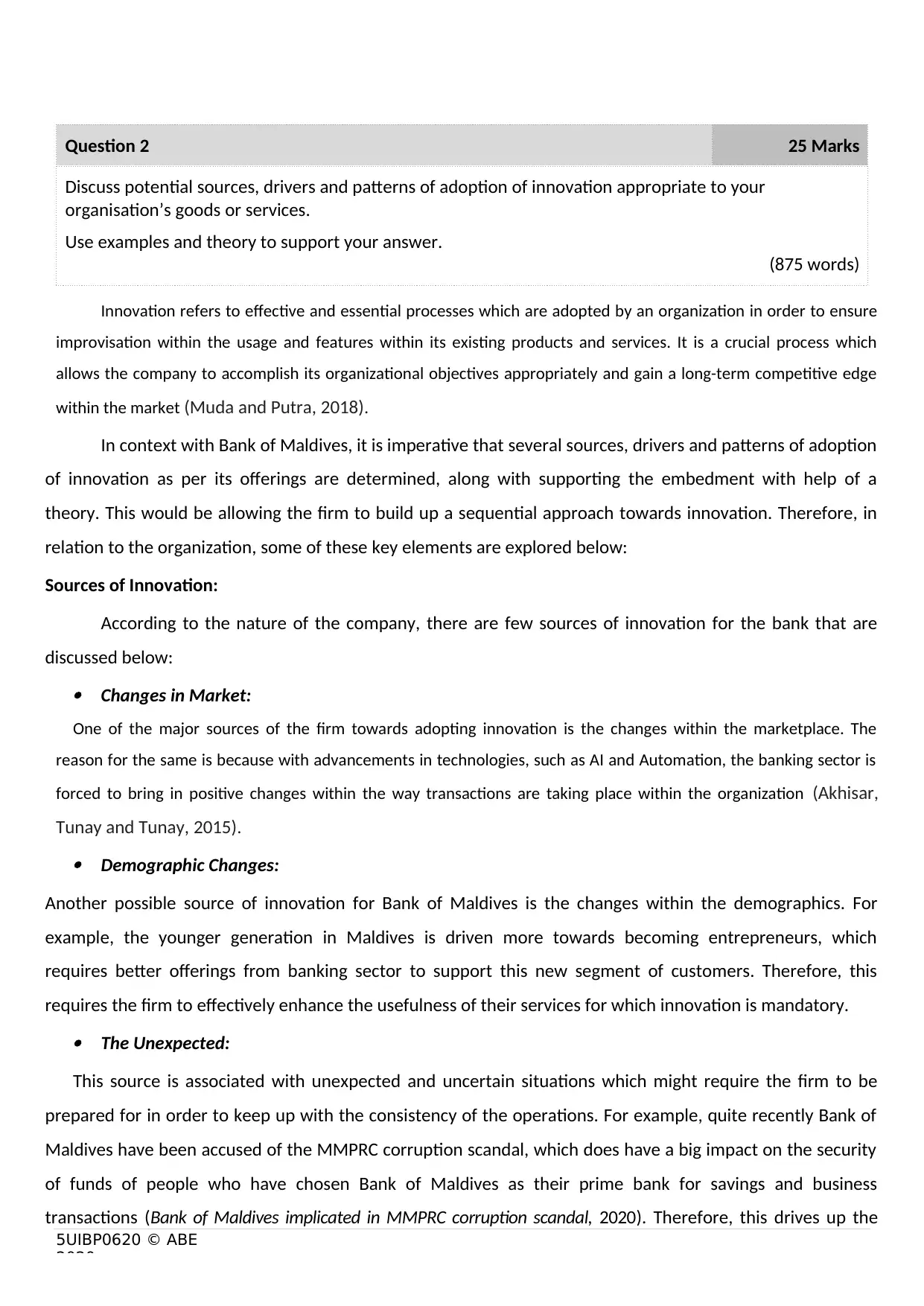
5UIBP0620 © ABE
2020
Question 2 25 Marks
Discuss potential sources, drivers and patterns of adoption of innovation appropriate to your
organisation’s goods or services.
Use examples and theory to support your answer.
(875 words)
Innovation refers to effective and essential processes which are adopted by an organization in order to ensure
improvisation within the usage and features within its existing products and services. It is a crucial process which
allows the company to accomplish its organizational objectives appropriately and gain a long-term competitive edge
within the market (Muda and Putra, 2018).
In context with Bank of Maldives, it is imperative that several sources, drivers and patterns of adoption
of innovation as per its offerings are determined, along with supporting the embedment with help of a
theory. This would be allowing the firm to build up a sequential approach towards innovation. Therefore, in
relation to the organization, some of these key elements are explored below:
Sources of Innovation:
According to the nature of the company, there are few sources of innovation for the bank that are
discussed below:
Changes in Market:
One of the major sources of the firm towards adopting innovation is the changes within the marketplace. The
reason for the same is because with advancements in technologies, such as AI and Automation, the banking sector is
forced to bring in positive changes within the way transactions are taking place within the organization (Akhisar,
Tunay and Tunay, 2015).
Demographic Changes:
Another possible source of innovation for Bank of Maldives is the changes within the demographics. For
example, the younger generation in Maldives is driven more towards becoming entrepreneurs, which
requires better offerings from banking sector to support this new segment of customers. Therefore, this
requires the firm to effectively enhance the usefulness of their services for which innovation is mandatory.
The Unexpected:
This source is associated with unexpected and uncertain situations which might require the firm to be
prepared for in order to keep up with the consistency of the operations. For example, quite recently Bank of
Maldives have been accused of the MMPRC corruption scandal, which does have a big impact on the security
of funds of people who have chosen Bank of Maldives as their prime bank for savings and business
transactions (Bank of Maldives implicated in MMPRC corruption scandal, 2020). Therefore, this drives up the
2020
Question 2 25 Marks
Discuss potential sources, drivers and patterns of adoption of innovation appropriate to your
organisation’s goods or services.
Use examples and theory to support your answer.
(875 words)
Innovation refers to effective and essential processes which are adopted by an organization in order to ensure
improvisation within the usage and features within its existing products and services. It is a crucial process which
allows the company to accomplish its organizational objectives appropriately and gain a long-term competitive edge
within the market (Muda and Putra, 2018).
In context with Bank of Maldives, it is imperative that several sources, drivers and patterns of adoption
of innovation as per its offerings are determined, along with supporting the embedment with help of a
theory. This would be allowing the firm to build up a sequential approach towards innovation. Therefore, in
relation to the organization, some of these key elements are explored below:
Sources of Innovation:
According to the nature of the company, there are few sources of innovation for the bank that are
discussed below:
Changes in Market:
One of the major sources of the firm towards adopting innovation is the changes within the marketplace. The
reason for the same is because with advancements in technologies, such as AI and Automation, the banking sector is
forced to bring in positive changes within the way transactions are taking place within the organization (Akhisar,
Tunay and Tunay, 2015).
Demographic Changes:
Another possible source of innovation for Bank of Maldives is the changes within the demographics. For
example, the younger generation in Maldives is driven more towards becoming entrepreneurs, which
requires better offerings from banking sector to support this new segment of customers. Therefore, this
requires the firm to effectively enhance the usefulness of their services for which innovation is mandatory.
The Unexpected:
This source is associated with unexpected and uncertain situations which might require the firm to be
prepared for in order to keep up with the consistency of the operations. For example, quite recently Bank of
Maldives have been accused of the MMPRC corruption scandal, which does have a big impact on the security
of funds of people who have chosen Bank of Maldives as their prime bank for savings and business
transactions (Bank of Maldives implicated in MMPRC corruption scandal, 2020). Therefore, this drives up the
⊘ This is a preview!⊘
Do you want full access?
Subscribe today to unlock all pages.

Trusted by 1+ million students worldwide
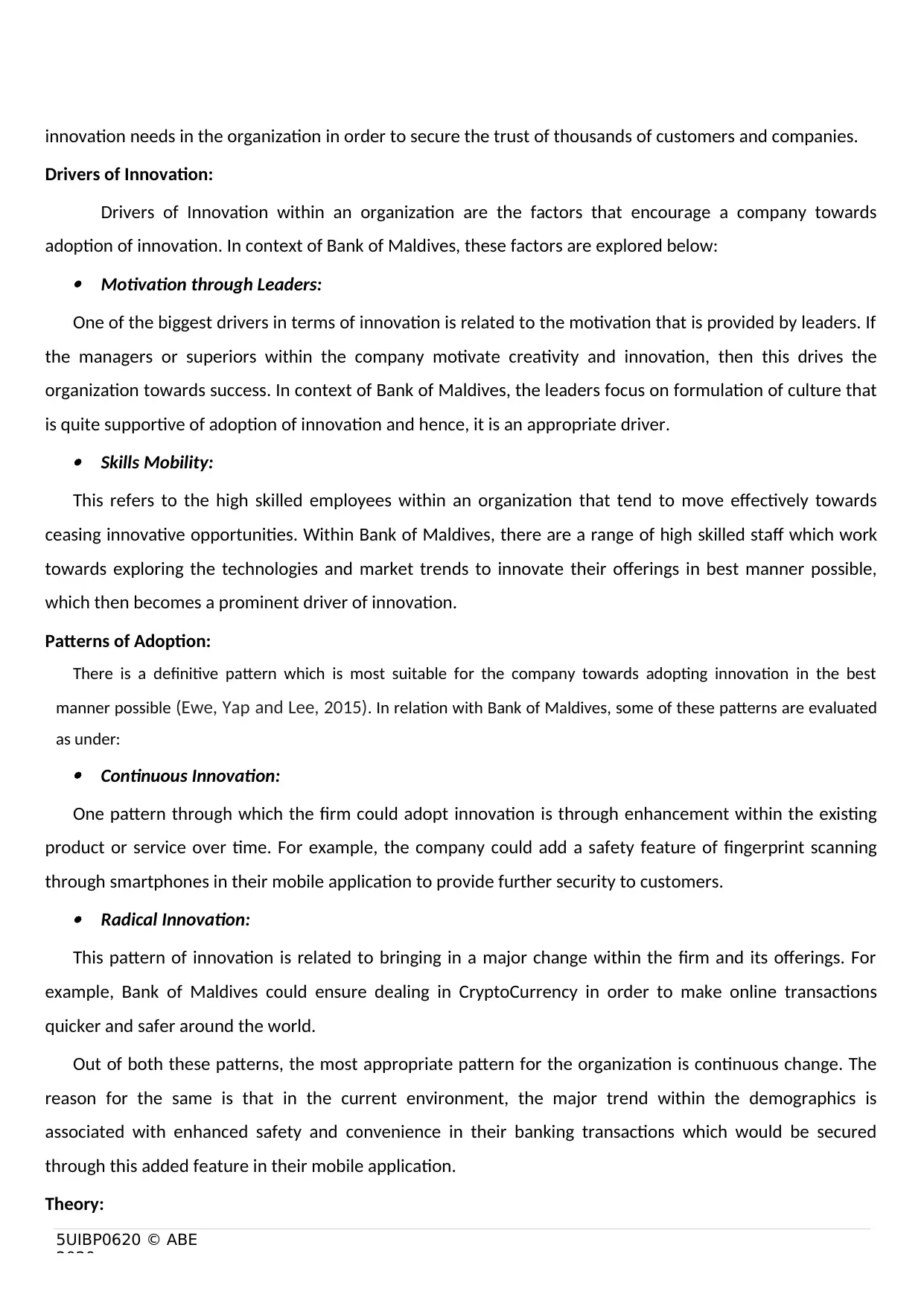
5UIBP0620 © ABE
2020
innovation needs in the organization in order to secure the trust of thousands of customers and companies.
Drivers of Innovation:
Drivers of Innovation within an organization are the factors that encourage a company towards
adoption of innovation. In context of Bank of Maldives, these factors are explored below:
Motivation through Leaders:
One of the biggest drivers in terms of innovation is related to the motivation that is provided by leaders. If
the managers or superiors within the company motivate creativity and innovation, then this drives the
organization towards success. In context of Bank of Maldives, the leaders focus on formulation of culture that
is quite supportive of adoption of innovation and hence, it is an appropriate driver.
Skills Mobility:
This refers to the high skilled employees within an organization that tend to move effectively towards
ceasing innovative opportunities. Within Bank of Maldives, there are a range of high skilled staff which work
towards exploring the technologies and market trends to innovate their offerings in best manner possible,
which then becomes a prominent driver of innovation.
Patterns of Adoption:
There is a definitive pattern which is most suitable for the company towards adopting innovation in the best
manner possible (Ewe, Yap and Lee, 2015). In relation with Bank of Maldives, some of these patterns are evaluated
as under:
Continuous Innovation:
One pattern through which the firm could adopt innovation is through enhancement within the existing
product or service over time. For example, the company could add a safety feature of fingerprint scanning
through smartphones in their mobile application to provide further security to customers.
Radical Innovation:
This pattern of innovation is related to bringing in a major change within the firm and its offerings. For
example, Bank of Maldives could ensure dealing in CryptoCurrency in order to make online transactions
quicker and safer around the world.
Out of both these patterns, the most appropriate pattern for the organization is continuous change. The
reason for the same is that in the current environment, the major trend within the demographics is
associated with enhanced safety and convenience in their banking transactions which would be secured
through this added feature in their mobile application.
Theory:
2020
innovation needs in the organization in order to secure the trust of thousands of customers and companies.
Drivers of Innovation:
Drivers of Innovation within an organization are the factors that encourage a company towards
adoption of innovation. In context of Bank of Maldives, these factors are explored below:
Motivation through Leaders:
One of the biggest drivers in terms of innovation is related to the motivation that is provided by leaders. If
the managers or superiors within the company motivate creativity and innovation, then this drives the
organization towards success. In context of Bank of Maldives, the leaders focus on formulation of culture that
is quite supportive of adoption of innovation and hence, it is an appropriate driver.
Skills Mobility:
This refers to the high skilled employees within an organization that tend to move effectively towards
ceasing innovative opportunities. Within Bank of Maldives, there are a range of high skilled staff which work
towards exploring the technologies and market trends to innovate their offerings in best manner possible,
which then becomes a prominent driver of innovation.
Patterns of Adoption:
There is a definitive pattern which is most suitable for the company towards adopting innovation in the best
manner possible (Ewe, Yap and Lee, 2015). In relation with Bank of Maldives, some of these patterns are evaluated
as under:
Continuous Innovation:
One pattern through which the firm could adopt innovation is through enhancement within the existing
product or service over time. For example, the company could add a safety feature of fingerprint scanning
through smartphones in their mobile application to provide further security to customers.
Radical Innovation:
This pattern of innovation is related to bringing in a major change within the firm and its offerings. For
example, Bank of Maldives could ensure dealing in CryptoCurrency in order to make online transactions
quicker and safer around the world.
Out of both these patterns, the most appropriate pattern for the organization is continuous change. The
reason for the same is that in the current environment, the major trend within the demographics is
associated with enhanced safety and convenience in their banking transactions which would be secured
through this added feature in their mobile application.
Theory:
Paraphrase This Document
Need a fresh take? Get an instant paraphrase of this document with our AI Paraphraser
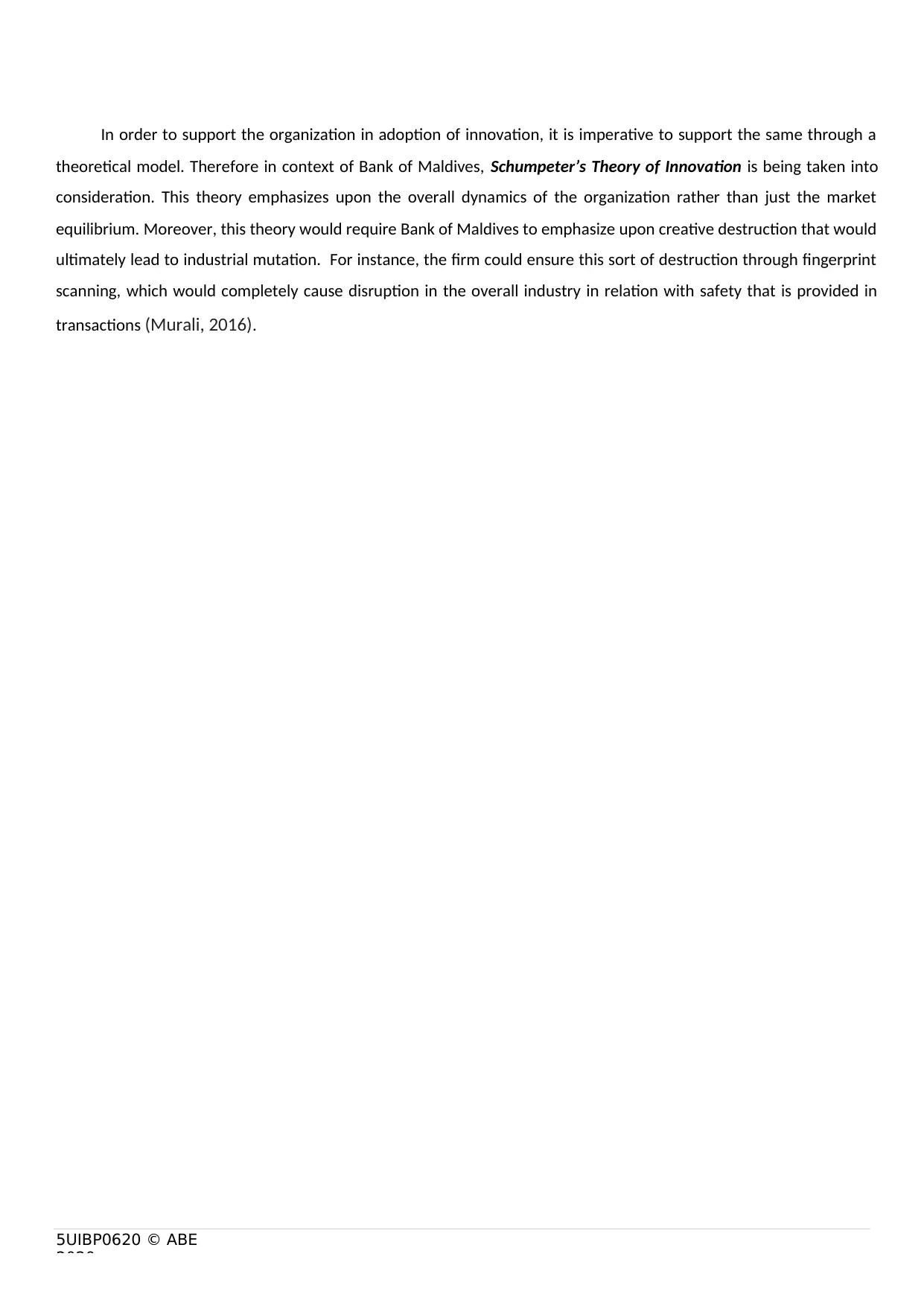
5UIBP0620 © ABE
2020
In order to support the organization in adoption of innovation, it is imperative to support the same through a
theoretical model. Therefore in context of Bank of Maldives, Schumpeter’s Theory of Innovation is being taken into
consideration. This theory emphasizes upon the overall dynamics of the organization rather than just the market
equilibrium. Moreover, this theory would require Bank of Maldives to emphasize upon creative destruction that would
ultimately lead to industrial mutation. For instance, the firm could ensure this sort of destruction through fingerprint
scanning, which would completely cause disruption in the overall industry in relation with safety that is provided in
transactions (Murali, 2016).
2020
In order to support the organization in adoption of innovation, it is imperative to support the same through a
theoretical model. Therefore in context of Bank of Maldives, Schumpeter’s Theory of Innovation is being taken into
consideration. This theory emphasizes upon the overall dynamics of the organization rather than just the market
equilibrium. Moreover, this theory would require Bank of Maldives to emphasize upon creative destruction that would
ultimately lead to industrial mutation. For instance, the firm could ensure this sort of destruction through fingerprint
scanning, which would completely cause disruption in the overall industry in relation with safety that is provided in
transactions (Murali, 2016).
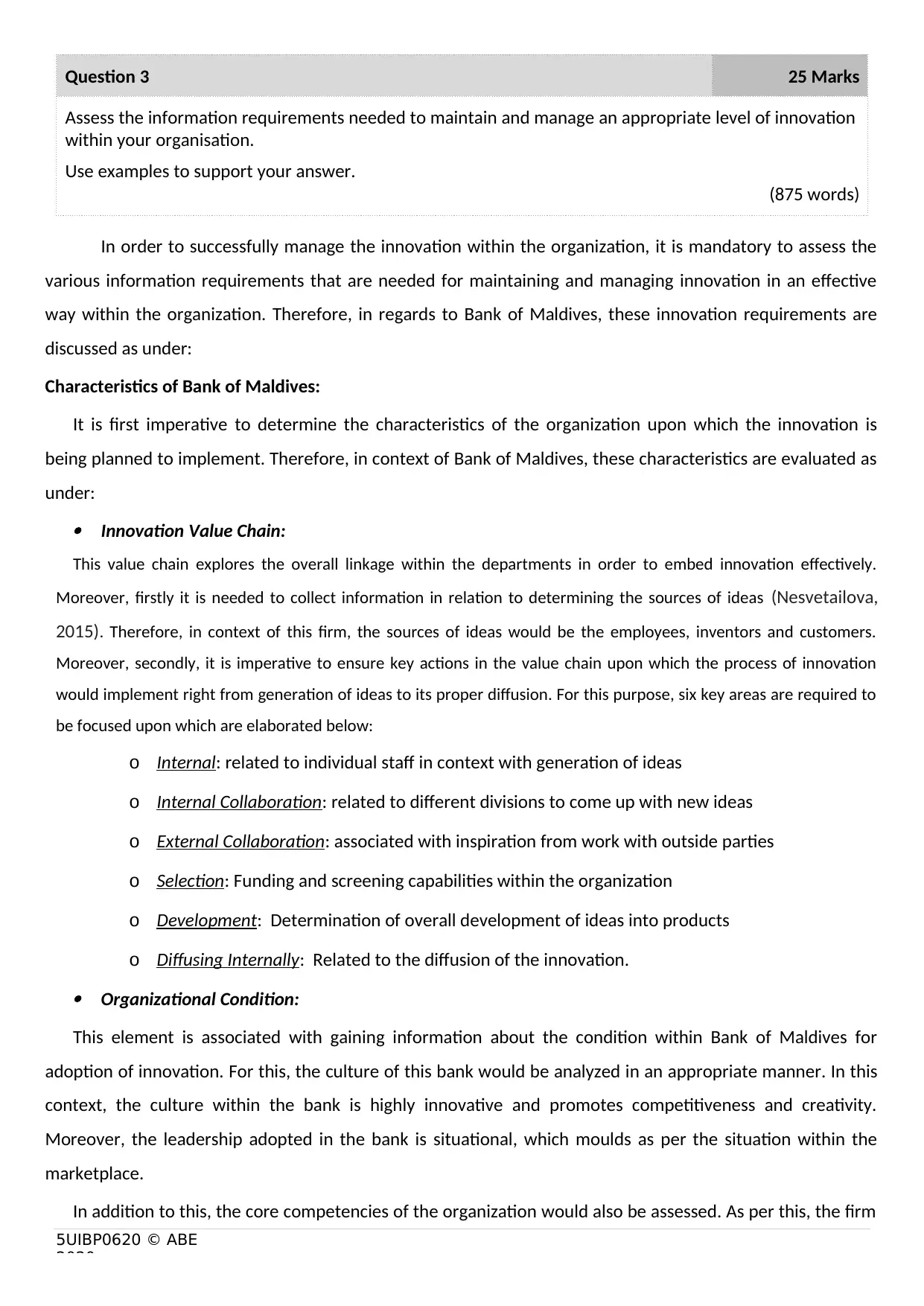
5UIBP0620 © ABE
2020
Question 3 25 Marks
Assess the information requirements needed to maintain and manage an appropriate level of innovation
within your organisation.
Use examples to support your answer.
(875 words)
In order to successfully manage the innovation within the organization, it is mandatory to assess the
various information requirements that are needed for maintaining and managing innovation in an effective
way within the organization. Therefore, in regards to Bank of Maldives, these innovation requirements are
discussed as under:
Characteristics of Bank of Maldives:
It is first imperative to determine the characteristics of the organization upon which the innovation is
being planned to implement. Therefore, in context of Bank of Maldives, these characteristics are evaluated as
under:
Innovation Value Chain:
This value chain explores the overall linkage within the departments in order to embed innovation effectively.
Moreover, firstly it is needed to collect information in relation to determining the sources of ideas (Nesvetailova,
2015). Therefore, in context of this firm, the sources of ideas would be the employees, inventors and customers.
Moreover, secondly, it is imperative to ensure key actions in the value chain upon which the process of innovation
would implement right from generation of ideas to its proper diffusion. For this purpose, six key areas are required to
be focused upon which are elaborated below:
o Internal: related to individual staff in context with generation of ideas
o Internal Collaboration: related to different divisions to come up with new ideas
o External Collaboration: associated with inspiration from work with outside parties
o Selection: Funding and screening capabilities within the organization
o Development: Determination of overall development of ideas into products
o Diffusing Internally: Related to the diffusion of the innovation.
Organizational Condition:
This element is associated with gaining information about the condition within Bank of Maldives for
adoption of innovation. For this, the culture of this bank would be analyzed in an appropriate manner. In this
context, the culture within the bank is highly innovative and promotes competitiveness and creativity.
Moreover, the leadership adopted in the bank is situational, which moulds as per the situation within the
marketplace.
In addition to this, the core competencies of the organization would also be assessed. As per this, the firm
2020
Question 3 25 Marks
Assess the information requirements needed to maintain and manage an appropriate level of innovation
within your organisation.
Use examples to support your answer.
(875 words)
In order to successfully manage the innovation within the organization, it is mandatory to assess the
various information requirements that are needed for maintaining and managing innovation in an effective
way within the organization. Therefore, in regards to Bank of Maldives, these innovation requirements are
discussed as under:
Characteristics of Bank of Maldives:
It is first imperative to determine the characteristics of the organization upon which the innovation is
being planned to implement. Therefore, in context of Bank of Maldives, these characteristics are evaluated as
under:
Innovation Value Chain:
This value chain explores the overall linkage within the departments in order to embed innovation effectively.
Moreover, firstly it is needed to collect information in relation to determining the sources of ideas (Nesvetailova,
2015). Therefore, in context of this firm, the sources of ideas would be the employees, inventors and customers.
Moreover, secondly, it is imperative to ensure key actions in the value chain upon which the process of innovation
would implement right from generation of ideas to its proper diffusion. For this purpose, six key areas are required to
be focused upon which are elaborated below:
o Internal: related to individual staff in context with generation of ideas
o Internal Collaboration: related to different divisions to come up with new ideas
o External Collaboration: associated with inspiration from work with outside parties
o Selection: Funding and screening capabilities within the organization
o Development: Determination of overall development of ideas into products
o Diffusing Internally: Related to the diffusion of the innovation.
Organizational Condition:
This element is associated with gaining information about the condition within Bank of Maldives for
adoption of innovation. For this, the culture of this bank would be analyzed in an appropriate manner. In this
context, the culture within the bank is highly innovative and promotes competitiveness and creativity.
Moreover, the leadership adopted in the bank is situational, which moulds as per the situation within the
marketplace.
In addition to this, the core competencies of the organization would also be assessed. As per this, the firm
⊘ This is a preview!⊘
Do you want full access?
Subscribe today to unlock all pages.

Trusted by 1+ million students worldwide
1 out of 19
Related Documents
Your All-in-One AI-Powered Toolkit for Academic Success.
+13062052269
info@desklib.com
Available 24*7 on WhatsApp / Email
![[object Object]](/_next/static/media/star-bottom.7253800d.svg)
Unlock your academic potential
Copyright © 2020–2025 A2Z Services. All Rights Reserved. Developed and managed by ZUCOL.





